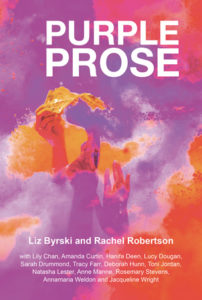Fremantle Press
2015
$27.99
 If the idea of reading about what one colour means to fifteen writers sounds, well—how shall I put this delicately—rather monochromatic, think again. The result is technicoloured, multifaceted, shimmering.
If the idea of reading about what one colour means to fifteen writers sounds, well—how shall I put this delicately—rather monochromatic, think again. The result is technicoloured, multifaceted, shimmering.
Writers Liz Byrski and Rachel Robertson cooked up the scheme in Liz’s herb scented courtyard when Rachel mused that she would like to write about purple but didn’t want to write a whole book. Liz suggested an anthology of women writing about purple, and so Purple Prose was born.
The colour purple has of course, they point out, many different associations already across cultures, including feminism and the suffragette movement, lesbian, gay and transgender rights, royalty, wealth, healing and spirituality. There are purple occurrences in nature: purple flowers, vegetables, animals, insects and minerals.
The choice to orient the book around the one colour called to my mind the suggestion that constriction, rather than limiting, can actually nurture creativity. Reading the book, this notion makes me think of an eagle that circles around the one point: it can soar far and wide.
What Purple Prose gives the reader, pacing around and around that one word, purple, is a surprising, colourful, diverse and deeply-felt suite of memoir and personal essay.
Toni Jordon, author of the wonderful Addition, writes about her mother’s downright balladry and flair for swearing, or purple language in the American English, that emerged during her first pregnancy. Jordan writes about the representation of cussing in fiction, but it is her depiction of her mother’s swearing and the almost visceral powers of protection this afforded the children of a single mother, that really strikes a chord.
Deborah Hunn writes a sustained, touching account of her pride and love for the Fremantle Dockers AFL team, whose new all-purple kit she observes is ‘so wonderfully, unintentionally queer’.
Sarah Drummond gives us a charming, funny account of what happens when she finds a pigeon’s leg tag beneath a slick of purple feathers in a mountain rock pool and is introduced to the fascinating world of pigeon fanciers, those who race pigeons.
Tracey Farr, research scientist turned novelist, muses on the singularity of seeing experienced by both readers of fiction and the eye to vision. ‘Does purple for you look the same as purple for me?’, she wonders.
Amanda Curtin explores the politics of aging and the red-hatters, women who have heeded Jenny Joseph’s poem ‘Warning’ and taken to the wearing of a purple dress with a red hat, becoming the subversive old woman they always intended to be one day, in the here and now.
Curtis cites Hilary Mantel’s observation that, contrary to this, ‘in the time and place of her childhood, women over fifty were not invisible; in fact, they were so sturdily visible they “blacked out the sky” and ruled the world… “unyielding, undaunted and savagely unimpressed by anything the world could do to them”’. Like Curtis, I also love that depiction. Aging and the lives of older women is a thematic that emerges in many of the stories.
As much as Puple Prose is a meditation on the colour purple, it is a meditation on the power of story in our lives. Liz and Rachel note: ‘Apart from the colour purple, we recognised that each of these works is about how we make our lives into stories and how that makes our lives richer’.
Compared to other memoir and essay books, Purple Prose offers an unusual format and framing. The nearest thing I can think of to its effect is the Women of Letters series, which features a suite of voices constricted by the intimacy of the letter format.
As the writer’s of Purple Prose rummage through the treasure troves of their memories to make meaning out of the word purple, there is a wealth for the reader. Not all of the stories are neatly coherent. In fact, it is the disparate fragments held up to the light in the name of purple that give the book its depth and interest. Connections are made that may not have been made otherwise.
Purple Prose is a delightful, deeply human book well worth a read.

